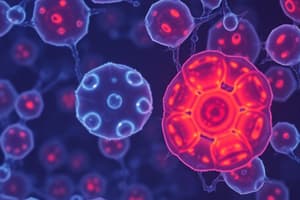Podcast
Questions and Answers
Which organelle is responsible for the packaging and distribution of proteins within the cell?
Which organelle is responsible for the packaging and distribution of proteins within the cell?
- Ribosome
- Endoplasmic reticulum
- Golgi apparatus (correct)
- Lysosome
What is the primary function of the plasma membrane in eukaryotic cells?
What is the primary function of the plasma membrane in eukaryotic cells?
- To store genetic information
- To facilitate cellular communication
- To provide structural support
- To regulate the movement of substances in and out of the cell (correct)
During the process of mitosis, what happens to the chromatin material in the nucleus?
During the process of mitosis, what happens to the chromatin material in the nucleus?
- The chromatin fiber coils tightly around histones (correct)
- The chromatin material is dispersed throughout the cytoplasm
- The chromatin material is replicated
- The chromatin material is destroyed
Which of the following is the correct process for cell division in prokaryotes?
Which of the following is the correct process for cell division in prokaryotes?
What is the primary mode of intercellular communication in eukaryotic cells?
What is the primary mode of intercellular communication in eukaryotic cells?
Which of the following statements about prokaryotic cells is true?
Which of the following statements about prokaryotic cells is true?
Which of the following organelles is responsible for the breakdown and recycling of cellular components in eukaryotic cells?
Which of the following organelles is responsible for the breakdown and recycling of cellular components in eukaryotic cells?
Which of the following statements about eukaryotic cells is false?
Which of the following statements about eukaryotic cells is false?
What is the primary function of ribosomes in prokaryotic cells?
What is the primary function of ribosomes in prokaryotic cells?
What is the primary function of mitochondria in eukaryotic cells?
What is the primary function of mitochondria in eukaryotic cells?
Which of the following techniques or technologies has been instrumental in advancing our understanding of cell biology?
Which of the following techniques or technologies has been instrumental in advancing our understanding of cell biology?
Which of the following is a key difference between prokaryotic and eukaryotic cells?
Which of the following is a key difference between prokaryotic and eukaryotic cells?
Flashcards are hidden until you start studying
Study Notes
Cell Biology
Cell biology is a discipline within the broader field of biology that focuses on the study of cell structure and function. It covers both prokaryotic and eukaryotic cells, seeking to understand how they operate, grow, divide, and communicate with each other. Throughout history, significant advancements in cell biology have been driven by advancements in microscopy techniques and technologies that allow scientists to observe cell structures and processes more closely.
Prokaryotic Cells
Prokaryotes are unicellular organisms with no enclosed nucleus or other membrane-bound organelles. They include bacteria and archaea. Despite their simplicity, these cells play crucial roles in various ecosystems and have provided valuable insights into the basic principles of life.
Structure of Prokaryotic Cells
The structure of prokaryotic cells is relatively simple compared to eukaryotic cells. The cytoplasm contains all the biochemical machinery required for life, including ribosomes responsible for protein production. Nuclear material, known as a nucleoid, is distributed throughout the cytoplasm rather than being encapsulated by a nuclear membrane.
Eukaryotic Cells
Eukaryotes are multicellular or unicellular organisms whose cells possess a defined nucleus, mitochondria, and other membrane-bound organelles. These organelles perform specialized functions necessary for the maintenance and survival of the cell.
Structure of Eukaryotic Cells
The main components of eukaryotic cells include the plasma membrane, cytoplasm, nucleus, and several organelles. The plasma membrane regulates the movement of substances into and out of the cell. The cytoplasm contains various organelles like ribosomes, endoplasmic reticulum, Golgi apparatus, and lysosomes. The nucleus contains the cell's genetic information stored in chromatin and is surrounded by a double membrane.
Modes of Cell Division
Prokaryotes and eukaryotes employ distinct mechanisms for cell division: binary fission and mitosis, respectively. Prokaryotes divide by binary fission, where the cytoplasm divides and separates into two daughter cells. Mitosis, on the other hand, occurs in eukaryotic cells. During mitosis, the nuclear material condenses, the chromatin fiber coils tightly around histones, proteins that help package DNA into a manageable structure. Spindle fibers attach to the sister chromatids and pull them apart, resulting in two distinct nuclei and organelles within each new cell.
Cellular Communication
Cells communicate with each other through various mechanisms. In prokaryotes, gene regulation mediated by regulatory proteins operates as a means of intracellular communication. In eukaryotes, hormones and neurotransmitters act as chemical messengers for intercellular communication. Additionally, direct contact between cells facilitated by adhesion molecules can influence their behavior.
In conclusion, cell biology encompasses the study of cell structure and function, covering both prokaryotic and eukaryotic cells. Advancements in microscopy techniques and technologies have allowed scientists to delve deeper into understanding these fundamental units of life, providing valuable insights into biological processes and diseases.
Studying That Suits You
Use AI to generate personalized quizzes and flashcards to suit your learning preferences.




